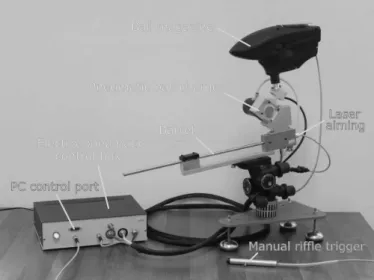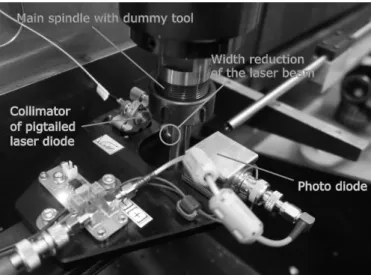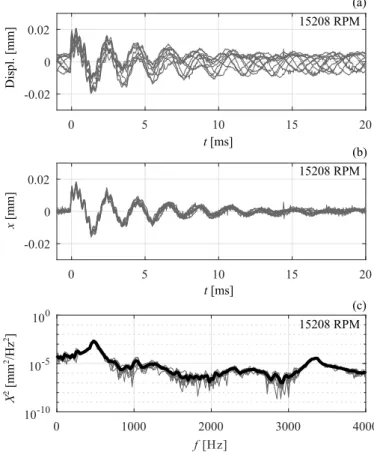Available online at www.sciencedirect.com
Procedia CIRP 00 (2018) 000–000 www.elsevier.com/locate/procedia
8th CIRP Conference on High Performance Cutting (HPC 2018)
Ball shooting tests for identification of modal parameter variation in rotating main spindles
D´enes Tak´acs
a,*, Rich´ard Wohlfart
b, ´ Akos Mikl´os
a, G´abor Krajny´ak
b, Andr´as T´oth
c, G´abor St´ep´an
baMTA-BME Research Group on Dynamics of Machines and Vehicles, Budapest H-1111, Hungary
bDepartment of Applied Mechanics, Budapest University of Technology and Economics, Budapest H-1111, Hungary
cDepartment of Manufacturing Science and Engineering, Budapest University of Technology and Economics, Budapest H-1111, Hungary
∗Corresponding author. Tel.:+36-1-453-1227; fax:+36-1-463-3471. E-mail address: takacs@mm.bme.hu
Abstract
The dynamical properties of the main spindle of a milling machine can have essential effect on the stability of milling processes. These dynamical properties often change with the rotational speed of the spindle, e.g. the stiffness and damping properties of the angular contact bearings of the spindle vary significantly with the spindle speed. Our study focuses on the development of measurement devices which enable us to measure the dynamical properties of rotating spindles with high accuracy. The concept of the Fotonic Beam Reduction (FBR) laser sensor is presented, which is applied to measure the displacement of rotating milling tools in a contactless way. In order to determine the frequency response function (FRF) of the spindle, a ball shooter is constructed. The impulse generated by the bullet on the target is analysed experimentally. A force sensor is utilized to estimate the time interval of the impacting between bullet and surface. It is shown that the repeatability of the impact is very good, and the generated impulse can excite the natural frequencies up to 30 kHz. The FBR sensor with the ball shooter is applied to identify the FRF of a milling spindle versus its rotational speed. The variation of the vibration frequencies is demonstrated by means of the experiments.
c
2018 The Authors. Published by Elsevier Ltd.
Peer-review under the responsibility of the International Scientific Committee of the 8th CIRP Conference on High Performance Cutting (HPC 2018).
Keywords: ball impact; contactless sensor; modal test; spindle dynamics
1. Introduction
Chatter vibration is a well-known problem in machining. Al- though the basic model that could explain chatter dates back to the 1960’s [1,2], the elimination of this stability problem is a difficult task for engineers even nowadays. Theoretical in- vestigations are ready to predict stable and unstable parame- ter ranges of the machining [3], but practical experiences show some quantitative error of the prediction. Namely, the structure of the stability charts can be identified in practice but some shift of the stability boundaries are usually present.
The application in the industrial field of chatter prediction approaches is hindered by the large amount of complicated measurements and high-level expertise that are required. In or- der to partially avoid such measurements – that would be rec- ommended for each tooling system – some best guess values may be assigned to model coefficients. Nevertheless, this typ- ically leads to unreliable results or to robust stable parameters that may be too prudential in case of some robust chatter pre- diction algorithm used for taking into account the large model coefficients uncertainties [4].
Instead of carry out extensive experiments for the accurate parameter identification for each tooling system, a good com-
promise would be to measure spindle dynamics only once by using a dedicated device – such as that developed in this study – with tooling system dynamics measured off-line in the tool room or estimated through finite element analysis and finally coupling them together by using receptance coupling method- ologies [5–7].
In the past decades, researchers tried to verify and consider the formally unmodelled effects that may play a key role in the accuracy and robustness of the theoretical results on chatter pre- diction. In case of milling, the dynamical properties of the main spindle of the milling machine was verified to have a strong ef- fect on the stability of the milling process [8]. The dynamical properties of spindles often change with the rotational speed.
To construct the theoretical stability charts of milling processes, natural frequencies, damping ratios of the vibration modes are needed. In most common cases, the frequency response func- tion (FRF) of the tool side is measured with impact hammers and accelerometers attached to the tool tip. On the one hand, this measurement setup can have some uncertainty due the non- ideal impacts [9]. On the other hand, the measurement can be carried out only in case the spindle is not rotating. However, it is well known, that stiffness and damping parameters of an- gular contact bearings vary with the rotational speed, and the
2212-8271 c2018 The Authors. Published by Elsevier Ltd.
Peer-review under the responsibility of the International Scientific Committee of the 8th CIRP Conference on High Performance Cutting (HPC 2018).
2 Denes Takacs et al./Procedia CIRP 00 (2018) 000–000
gyroscopic effect can also be relevant at high rotational speed (see [8]). To identify the variation of the parameters of the spin- dle with respect to the rotational speed, measurement has to be carried out meanwhile the spindle rotates.
To identify FRFs of the main spindle during rotation with good accuracy, the tasks of both the excitation and the measure- ment of the response have to be solved. In most common cases, modal hammers are applied to excite the system by means of impacts. But hitting a rotating tool by a hammer has a relevant safety risk. Using contactless electromagnetic actuators could be a good solution [10,11] but this technology requires the use of dummy tools and the technology is very expensive. Electro- magnetic bearings can also be used for excitation via the imple- mentation of specific control task in the bearing control [12].
Measuring the vibration of rotating tools is also well-known problem. Various frequencies and small displacements are characterizing the vibrations that usually appear, meanwhile contactless measurement is required in order to eliminate any perturbation of the studied phenomenon.
All the above mentioned problems motivated us to develop a new concept for the measurement of the dynamical properties of main spindles in wide frequency and rotational speed ranges.
2. Concept for the measurement of modal parameters dur- ing rotation
Two new devices were developed by the SIREN ERC re- search group (siren.mm.bme.hu) to accomplish precise identi- fication of FRFs. These devices are shortly introduced in the following subsections.
2.1. Excitation
Fig. 1. The ball shooter.
A special ball shooter (see Fig. 1) was constructed to provide impact excitation by the use of airsoft ball bullets. The shooter is equipped with an automated feeder and with laser sight, and it can be digitally controlled in order to realize totally automated measurement processes.
The use of ball impacts to excite mechanical systems can be very advantageous in the following cases:
• the use of common modal hammers has safety risk (e.g., in case of rotating objects),
• the multiple-hitting phenomenon cannot be avoided easily,
• vibration modes with very high frequencies have to be ex- cited,
• the target object is small,
• it is difficult to get access to the desired location of the excitation.
The main disadvantage of the ball impact excitation is that the contact force, i.e. the excitation force, cannot be measured.
Consequently, the Fourier transform of the input signal of the modal test is unknown and the FRF of the system cannot be calculated. However, experimental tests and numerical inves- tigations explored that the spectrum of the contact force time signal can be assumed to be constant up to 30 kHz. Moreover, the repeatability of the ball impact is excellent. This is illus- trated in Fig. 2, where the time signal of a piezzo-electric force transducer is plotted, which was excited by the ball shooter 10 times. No relevant difference of the time signals can be ob- served, which suggests that the excitation forces are very simi- lar. The vibrations in the signals correspond to the fact that the sensor also realizes a dynamical system with its own vibration modes. However, a very short (about 30–40µs) contact time be- tween the sensor and the airsoft bullet can be predicted (shown by black curve) from the time histories, that was also confirmed by high speed camera records and by the FEA in [13].
-20 0 20 40 60 80 100 120 140
t [ s]
-500 0 500 1000
F [N]
Fig. 2. The force signals generated by 10 separated shots.
2.2. Displacement measurement
In order to measure precisely the dynamical properties of spindles during rotation, contactless sensors are needed. One of the most commonly used contactless sensor is the Laser- Doppler vibrometer that detects the velocity of the measured target. When the reflectivity of the target is not appropriate, the application of Laser-Doppler vibrometers is unhandy. More- over, if both the vibration frequency and the vibration ampli- tude are small, the velocity can be in that range, which cannot be measured easily. Another option to measure in a contactless way is the use of reflective laser based displacement sensors.
These sensors can be purchased with different measuring range and resolution, but the frequency bandwidth is usually low, and the resolution is also limited.
In order to exploit all the advantageous properties of laser based sensors, the Fotonic Beam Reduction (FBR) sensor was constructed in the SIREN ERC research project. The basic idea of this sensor is simple. A laser beam is tangentially directed
Denes Takacs et al./Procedia CIRP 00 (2018) 000–000 3
Main spindle with dummy tool
Photo diode Collimator
of pigtailed laser diode
Width reduction of the laser beam
Fig. 3. The Fotonic Beam Reduction (FBR) laser sensor.
to the cylindrical part of the rotating tool and the intensity of the laser beam is measured by a photodiode at the other side (see Fig. 3). Namely, the width of the laser beam is modi- fied by the tool displacements in the transversal direction of the laser beam, and accordingly, the intensity measured by the photodiode is also varied. The constructed sensor has 500 kHz frequency bandwidth, 10–100 nm resolution and cca. 0.3 mm measuring range. The characteristic of the sensor is shown in Fig. 4, where the sensitivity in the linear range of the sensor is also given. The RMS noise level of the sensor is identified to be below 10 nm.
1 2 3 4 5
U[V]
0 0.1 0.2 0.3 0.4
Displ. [mm]
Measured
Lin.fit, Sensitiviy = -0.03042 mm/V
Fig. 4. The characteristic of the Fotonic Beam Reduction (FBR) sensor.
3. Measurement results
A demonstration test was carried out on a TEKNOMOTOR C41/47-C-DB-ER25-HY 2.0kW motor spindle, in which two Germany HY SM 6007 C TXM P4 hybrid angular bearings with rigid preload are installed and grease lubrication is applied.
The experimental setup is shown in Fig. 5. The ball shooter was used to excite a dummy tool in radial direction. The diameter and the free length of the tool were 16 mm and 50 mm, re- spectively. On the other side of the tool the FBR sensor was used to measure the radial displacement. An NI DAQ system was applied to acquire the time signal of the FBR sensor mean- while the ball shooter and rotation speed of the spindle were also controlled using digital I/O and analogue output modules in the DAQ system.
Main spindle
Ball shooter Data acquisition
FBR sensor
Spindle drive
Measurement control
Fig. 5. The measurement setup.
In the measurement, the rotational speed of the spindle was set to various constant values from 0 to 18000 rpm. At each ap- plied rotational speed, the dummy tool was excited 10 times by the ball shooter and the displacement signal was recorded. In Fig. 6a, the time histories are shown for 15208 rpm, where t=0 is triggered to the time instant of the impact. Since the tool has runout, the measured displacement x of the impact-induced vi- bration is superposed onto the runout. The runout is subtracted from the displacement signal in Fig. 6b using the recorded sig- nals before the impacts. A very good similarity of the detected vibrations can be observed, namely, the repeatability of the air- soft excitation is excellent even in the case of rotating objects.
The spectra of the displacement signals are shown in Fig. 6c, where the black thick curve is the averaged spectrum of the 10 shots.
The averaged spectra of the detected vibrations are used to construct the Campbell diagram of the spindle that is presented in Fig. 7. The dashed lines represent the rotational frequency of the spindle and its higher harmonics while the shades of the fig- ures are representing the amplitudes of the averaged spectra that are interpolated along the vertical axis. In panel (a), the vibra- tion frequencies are shown up to 4 kHz. Two relevant vibration modes can be detected at cca. 470 Hz and at cca. 3400 Hz. The variations of these modes with respect to the rotational speed can be observed in panel (b) and (c), respectively. A slight in- crease of the first natural frequency can be experienced as the rotational speed is getting higher. Much relevant variation can be detected in case of the higher mode, which seems to vanish in a certain rotational speed range.
4. Conclusion
Novel measurement devices were introduced by which the dynamical properties of rotating spindles can be identified with high accuracy. A ball shooter was constructed that provides ex- citation in a wide frequency range with excellent repeatability, and can be used in automated measurement processes. The con- tactless measurement of the tool vibration was carried out by the Fotonic Beam Reduction (FBR) sensor, which has extraor- dinary properties both in resolution and frequency bandwidth.
The applicability of these devices was also demonstrated in the paper. The natural frequencies of a main spindle having hy- brid angular bearings were identified up to 4 kHz in the whole
4 Denes Takacs et al./Procedia CIRP 00 (2018) 000–000
0 5 10 15 20
t [ms]
-0.02 0 0.02
0 5 10 15 20
-0.02 0 0.02
0 1000 2000 3000 4000
f [Hz]
10-10 10-5 100
t [ms]
(a)
(b)
(c) 15208 RPM
15208 RPM
15208 RPM Displ. [mm]x [mm]X2 [mm2/Hz2]
Fig. 6. (a) The measured time signals related to 10 shots. (b) The displacement x of the dummy tool after the subtraction of the runout. (c) The spectra of the measured displacements.
rotational speed range of the spindle. The variation of the dy- namical properties of the main spindle were accurately identi- fied.
Acknowledgements
The research leading to these results has received fund- ing from the European Research Council under the European Unions Seventh Framework Programme (FP/2007-2013)/ERC Advanced Grant Agreement n. 340889.
References
[1] Tobias, S.. Schwingungen an Werkzeugmaschinen. Munchen: C Hanser;
1961.
[2] Tlusty, J., Polacek, A., Danek, C., Spacek, J.. Selbsterregte Schwingun- gen an Werkzeugmaschinen. Berlin: VEB Verlag Technik; 1962.
[3] Altintas, Y.. Manufacturing Automation - Metal Cutting Mechanics, Ma- chine Tool Vibrations and CNC Design, Second Edition. Cambridge: Cam- bridge University Press; 2012. doi:10.1115/1.1399383.
[4] Hajdu, D., Insperger, T., Stepan, G.. Robust stability analysis of ma- chining operations. The International Journal of Advanced Manufacturing Technology 2017;88(1):45–54. doi:10.1007/s00170-016-8715-0.
[5] Park, S.S., Altintas, Y., Movahhedy, M.. Receptance coupling for end mills. International Journal of Machine Tools and Manufacture 2003;43(9):889 – 896.
[6] Albertelli, P., Goletti, M., Monno, M.. A new receptance coupling substructure analysis methodology to improve chatter free cutting condi- tions prediction. International Journal of Machine Tools and Manufacture 2013;72:16–24.
0 1000 2000 3000 4000
f[Hz]
0 5000 10000 15000
Spindle speed [RPM]
300 400 500 600 700
f[Hz]
0 5000 10000 15000
3000 3200 3400 3600 3800 4000
f[Hz]
0 5000 10000 15000
(a)
(b)
(c)
Spindle speed [RPM]Spindle speed [RPM]
Fig. 7. The measured natural frequencies versus the rotational speed of the spindle. (a) Vibration modes detected up to 4 kHz. (b) The variation of the frequency of the first vibration mode. (c) The variation of the frequency of a higher vibration mode.
[7] Brecher, C., Chavan, P., Fey, M., Daniels, M.. A modal param- eter approach for receptance coupling of tools. MM Science Journal 2016;2016:1032–1034.
[8] Abele, E., Altintas, Y., Brecher, C.. Machine tool spindle units. {CIRP}Annals - Manufacturing Technology 2010;59(2):781 – 802.
doi:http://doi.org/10.1016/j.cirp.2010.05.002.
[9] Hajdu, D., Insperger, T., Stepan, G.. Robust stability of machining operations in case of uncertain frequency response functions. Procedia CIRP 2016;46:151 – 154. doi:https://doi.org/10.1016/j.procir.2016.03.181.
[10] Matsubara, A., Sawamura, R., Asano, K., Muraki, T.. Non-contact measurement of dynamic stiffness of rotating spindle. Procedia CIRP 2014;14:484 – 487. doi:http://dx.doi.org/10.1016/j.procir.2014.03.012.
[11] Rantatalo, M., Aidanpaa, J.O., Goransson, B., Norman, P.. Milling machine spindle analysis using fem and non-contact spindle excitation and response measurement. International Journal of Machine Tools and Manu- facture 207;47(7-8):1034 – 1045.
[12] Abele, E., Schiffler, A., Rothenb¨ucher, S.. System identification during milling via active magnetic bearing. Production Engineering 2007;1(3):309–314. doi:10.1007/s11740-007-0022-z.
[13] Berezvai, S., Kossa, A., Bachrathy, D., Stepan, G.. Numerical and experimental investigation of the applicability of pellet impacts for impulse excitation. International Journal of Impact Engineering 2018;.


